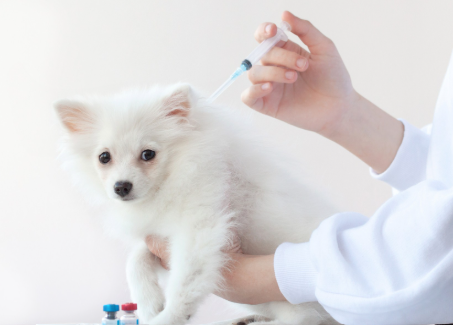Diabetes in dogs
Not only people suffer from diabetes, but also their pets. If your dog has become lethargic, is constantly thirsty and refuses its favorite treats, this is a reason to show it to a veterinarian. With timely treatment, the condition of an animal diagnosed with diabetes can be corrected, which will help your pet live a long life.

Diabetes in dogs: the main thing
- There are two forms of diabetes: type 1 (insulin-dependent) and type 2 (insulin-independent), the latter of which is extremely rare in dogs;
- The main symptoms of the disease include frequent urination and increased thirst (polyuria and polydipsia), increased appetite, weight loss and lethargy of the pet;
- The diagnosis is made through a series of blood and urine sugar tests;
- The main methods of treatment include the administration of insulin and the use of a special diet, but it is often impossible to completely get rid of the disease; it takes a chronic form;
- Most often, diabetes mellitus affects dogs of middle or old age.
Causes of the disease
The causes of diabetes in dogs have not yet been fully studied. It is believed that genetic predisposition, viral infections, and autoimmune disorders play a role in the development of the disease. The disease may appear due to a severe form of pancreatitis (inflammation of the pancreas), neoplasms, pancreatic trauma, endocrinological pathologies: for example, if the animal has Cushing’s syndrome (hyperadrenocorticism). In bitches, diabetes develops during estrus.
Symptoms of diabetes
As a rule, the early manifestations of the disease do not go unnoticed by the owners, because the main symptoms of diabetes in dogs include increased thirst and frequent urination. Pets can no longer wait 12 hours between walks and begin to relieve themselves at home. Owners may also notice an increased appetite, and the animal begins to lose weight. However, pets with diabetes are often severely obese, and therefore the first signs of weight loss go unnoticed by owners.
Later signs of diabetes in dogs include severe lethargy and drowsiness, which are caused by increasing intoxication of the body. Cataracts develop quite often in dogs.
Diagnostics
To detect diabetes, they use blood and urine sugar tests. Usually, first of all, at the appointment, they take a drop of blood from the ear and determine the glucose level using a regular glucometer – if the results are over 5 mmol / l, they begin in-depth diagnostics. A urine test is mandatory – a healthy pet should not have glucose in the urine, its presence confirms the disease. An extended biochemical blood test allows you to identify the presence of concomitant health problems, and a general blood test can show the presence of anemia and inflammation.
It is worth noting that in severe stress conditions in a clinic, some pets may have elevated blood sugar levels, which is not always a symptom of diabetes. In such cases, it is recommended to measure glucose at home (or a series of measurements) and be sure to collect urine for analysis in a calm environment.
An additional test to confirm the diagnosis is to measure fructosamine in the blood, a protein that transports glucose in the body. This test also helps to distinguish elevated glucose levels due to stress from a true disease.
Treatment of diabetes
When type 1 diabetes develops in dogs, lifelong insulin therapy is used. An important factor in successful treatment is the initial selection of the drug and its dose, so when the first signs of the disease are detected, it is recommended to hospitalize the pet.
The insulin of first choice is the medium-acting drugs. These drugs are administered to the pet 2 times a day with an interval of 11-12 hours between injections.
To select the dose of the drug, glucose measurements are taken before the insulin is administered, then 6 hours after. Then – before the evening injection for several days. Then the owner independently constantly monitors the glucose in the blood of his pet using a home glucometer.
If diabetes develops in a bitch during estrus, the disease is usually reversible with timely sterilization.
If rare type 2 diabetes is detected in a pet, hypoglycemic drugs are not used.
It is recommended to follow a specialized diet and exercise. If the pet is obese, gradual weight loss to the ideal weight over 2-4 months is recommended.
Nutrition for diabetes
Diet plays an important role in maintaining a good quality of life for your pet and preventing deterioration of the condition. Specialized ready-made diets for diabetes or a specially calculated diet from a veterinary nutritionist are used as nutrition for sick dogs. These diets are prescribed to pets for life.
With a natural diet, simple sugars are limited by adding complex carbohydrates to the diet; a moderate amount of protein; a fairly low fat content in the diet. To create a home diet, it is recommended to consult a veterinary nutritionist so that the diet is balanced. This can be done online in the Petstory mobile application. You can download it from the link .

Prevention
One of the predisposing factors for the development of diabetes in dogs can be obesity , so weight control of the pet is an important part of disease prevention. It is very important to feed the dog a balanced diet in accordance with its physiological needs, and to minimize the number of treats from the table. Sweets, buns, and cookies are absolutely unacceptable in dog nutrition.
Active walks also play an important role in disease prevention, since physical activity not only helps you lose weight, but also helps lower blood sugar levels.
Remember that it is always easier to prevent a disease than to treat it. Therefore, proper nutrition, active leisure and timely examinations by a veterinarian will help to maintain the health of your pet for many years.






